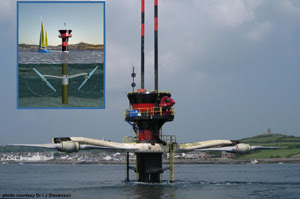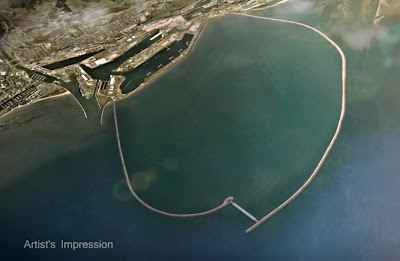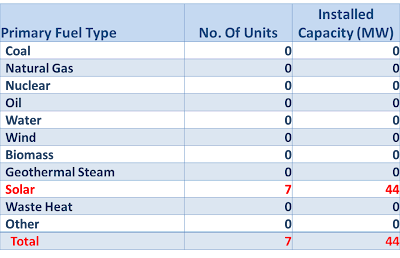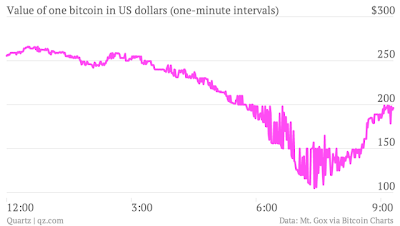Oil prices joined gold and other commodities in a full court market swoon, dropping from a high of $98 per barrel two weeks ago, for West Texas Intermediate, to close yesterday at close to $88 per barrel, a 10.2% drop. With United States oil consumption at 19.6 million barrels per day, this means a savings to our economy of $71.5 billion per year. Historically, oil prices at the high level that we have seen these past few years have caused recessions in the United States. The savings to our economy associated with this recent market drop for oil is a benefit to our economy.
The reason for the downswing in commodities is the galloping sense that the world economy may not be growing as expected, with the specific news Monday morning that China's growth in the first quarter this year was 7.7%, which is below the 7.9% of the last quarter of 2012, and below expectations that it would be closer to 8% in the first quarter of this year.
As a consequence, silver dropped as much as much as 11.5% in markets on Monday, and gold dropped 6.6% on Monday. As mentioned, oil has dropped 10.5% in the past two weeks. Below is the chart of WTI crude oil prices from October, 2012 through yesterday, April 15, 2013. Click on image below for larger view of the graph.
Tuesday, April 16, 2013
Saturday, April 13, 2013
Tidal Power Investment Surging - Commercialization On The Horizon
Tidal energy represents a significant power source, with one estimate of the addressable market being upwards of 3 TeraWatts, according to the IEA. This corresponds to 60% of the world's currently installed electricity generating capacity of 5.066 TeraWatts. The level of investment in advanced tidal energy technologies has increased significantly in the past decade, with scale deployments of new technologies currently underway. There are three major types of tidal power, each with different market sizes, technologies and levels of maturity.
Tidal Barrages
Tidal barrages are the most mature tidal technology, with three major installations around the world with more in the planning stage. These include the oldest installation, the 240 MW installation in Rance, France; the 17.8 MW Annapolis Royal Generating Station in Annapolis Royal, Canada; and the recently opened 254 MW Sihwa Lake Tidal Power Plant in South Korea.
 The Rance tidal barrage, also known as La Rance Power Station, is located in Brittany, France. The 240 MW installation was completed in 1967 and has several unique features. It serves as a causeway across the Rance estuary, significantly shortening the drive time along the French coast, between Dinard and St. Malo. In order to preserve boat access to the inland side of the barrage, a lock system was installed, along with a swing bridge for the roadway. The plant has 24 turbines, and produces approximately 600 GWh per year. Although the original cost to construct the facility was high, it has since been paid for, and the current marginal cost is less than that of nuclear power. The tidal flow in that section of France is approximately 8 meters, which is helpful for tidal power production. .
The Rance tidal barrage, also known as La Rance Power Station, is located in Brittany, France. The 240 MW installation was completed in 1967 and has several unique features. It serves as a causeway across the Rance estuary, significantly shortening the drive time along the French coast, between Dinard and St. Malo. In order to preserve boat access to the inland side of the barrage, a lock system was installed, along with a swing bridge for the roadway. The plant has 24 turbines, and produces approximately 600 GWh per year. Although the original cost to construct the facility was high, it has since been paid for, and the current marginal cost is less than that of nuclear power. The tidal flow in that section of France is approximately 8 meters, which is helpful for tidal power production. . The 17.8 MW Annapolis Royal Generating Station is located at the mouth of the Annapolis River on the Bay of Fundy, Nova Scotia, Canada. It was built over a four year period, and commissioned in 1984. There are some unique features associated with the facility. First off, it produces power only on the outgoing tide, allowing the head water basin to fill on the incoming tide, and then producing power over a five hour period on the outgoing tide. This cycle is repeated roughly twice per day, and produces approximately 80-100 MWhrs per day, depending on the ties. The tides in the Bay of Fundy average 12 meters, and can be as high as 16 meters. At the location of the Annapolis station average 7.5 meters, and can rise as high as 12 meters.
The Annapolis station uses a single-effect turbine, meaning that it generates power flowing in only one direction. The La Rance station, on the other hand, utilizes a double effect turbine, allowing for the extraction of power on both the incoming and outgoing tides. It has been best determined that double effect turbines require a higher head than single effect turbines. For the Annapolis station, it generates power upon conditions where there is at least a 1.6 meter differential between the head pond and sea level. The Annapolis turbine is quite large, with a 3 meter diameter.
Tidal Current
Tidal current systems are either horizontal axis two and three bladed turbines or vertical axis type turbine designs, known as axial turbines, positioned horizontally. Tidal current systems are typically secured to or positioned on the sea floor in arrays. These systems are just now emerging, with two designs having completed scale deployments and are taking commercial orders. The two most mature designs include the 1.2 MW SeaGen system in Strangford Lough in Northern Ireland; and the 180 kW TidGen deployment in Cobscook Bay, near Eastport, Maine.
The 1.2 MW SeaGen system in Strangford Lough in Northern Ireland was deployed in 2008, and has been in operation and under extensive testing since that time. The design is a monopole support, anchored to the sea floor, with a horizontal strut that supports two horizontal axis rotors at opposite ends. The rotors themselves have the highest weep area of any deployed system, of 402 square meters for the pair of rotors. Each rotor is 16 meters in diameter and spins at 14 rpm.
The system cost $18.36 million. The cross beam is designed to be raised and lowered to facilitate maintenance. The system is at the mouth of the Strangford Lough, or Loch, Southwest of Belfast, which encompasses 105 square kilometers of water, one of the largest coastal bays. The system produces up to 6,000 MWhrs per year, according to the company’s web site, corresponding to a 57% capacity factor, which is much higher than wind or solar.
The pitch of the blades can be adjusted up to 180 degrees, allowing for bidirectional flow and energy capture. Additionally, the blades are purposefully located in the top third of the water column, where the greatest water flow is found.
The company which manufactured the system is taking its experience and developing a 2 MW system for commercial deployment, with 20 meter diameter blades in a similar configuration. They are also planning a 3 MW system that is deployed in deeper waters, where the surface is not pierced by the system. The 3 MW design is in the very early stages of design at this time.
The 180 kW TidGen tidal generating system was deployed in Cobscook Bay, near Eastport, Maine, in August, 2012. The turbines are axial turbines, utilizing a blade design that appears to be similar to the twisting of DNA strands, with the axis horizontal and perpendicular to the flow of the water. The TidGen system utilizes a blade structure that is 98 feet long and 16 feet high in cross section. The system is designed to produce 180 kW at rated output, and plans are in place to increase the number of turbine systems deployed to produce 5 MW, requiring, as it appears, the deployment of 28 TidGen systems.
Tidal Lagoons
Tidal lagoons are large shallow areas defined by perimeter barriers, with a sluice way with turbines to generate power. There are no tidal lagoons currently built, although there are two major designs on the drawing board. One is the proposed 250 MW Swansea tidal lagoon in Swansea, UK. The other is the 300 MW near the mouth of the Yalu River in China. Tidal lagoons are expensive to build, but have higher capacity factors, of about 62%.
The proposed 250 MW Swansea tidal lagoon is an ambitious project proposed in Swansea England. The system relies on approximately 7 miles of barrages to be built, to create the lagoon. The expected cost of the project is $841 million. The system is designed to generate power on both the incoming and outgoing tides, estimated to operate for 16 hours per day.
Labels:
Annapolis,
La Rance,
SeaGen,
Swansea Tidal Lagoon,
tidal barrage,
tidal lagoon,
tidal power,
TidGen
Friday, April 12, 2013
US New Electric Generating Capacity Brought Online in March, 2013 is 100% Solar!
According to FERC's Office of Energy Projects, 100% of the electricity generating capacity brought online in March was solar. This likely has more to do with the absence of non-solar projects coming online in March. For the first quarter, representing January through March, 2013, solar represented 29% of the generating capacity brought online, and wind represented 51% of the generating capacity brought on line, with natural gas representing most of the remaining capacity brought online, 18%.
Here is a summary of the solar projects brought online in March, provided by FERC's Office of Energy Projects:
Here is a summary of the solar projects brought online in March, provided by FERC's Office of Energy Projects:
- NRG Energy Inc’s 26 MW Borrego Solar in San Diego County, CA is online. A second phase with 15 MW is expected to come online in June, 2013. The electricity generated is sold to San Diego G&E under long-term contract.
- City of Las Vegas’ 3 MW Las Vegas Waste Water Treatment Plant Solar in Clark County, NV is online. The electricity generated will supply 20 percent of the power needed by the nearby Water Pollution Control Facility.
- KDC Solar LLC’s 5 MW North Jersey Media Group Rockaway Solar in Morris County, NJ is online. The electricity generated will supply 60 percent of the power needed by North Jersey Media Group’s Rockaway printing plant.
- Two solar projects online in HI: 1) 6 MW Kalaeloa Solar One in Honolulu County. The electricity generated is sold to Hawaii Electric Company under longer-term contract. 2) 1.9 MW Bosch Maui County Solar in Maui. The electricity generated will supply 11 municipal facilities.
- BLU Leaf Energy Inc’s 1.15 MW Tanque Verde Unified School District Solar in Pima County, AZ is online. The electricity generated is sold to the school district under long-term contract.
- Weaver Cooke Construction’s 1.3 MW Greensboro Natural Science Center in Guilford County, NC is online. The electricity generated is sold to Duke Energy Carolinas under long-term contract.
Georgia Tech Builds Interactive GIS System for Analyzing United States Tidal Power Resources - Available for Public Use
Assessment of Energy Production Potential from Tidal Streams in the United States
Click on the image below to go to the Georgia Tech interactive GIS system.
Click on the image below to go to the Georgia Tech interactive GIS system.
Thursday, April 11, 2013
Bitcoin Prices Tumble 40% on Wild Trading Day After Rising 1561% in 3 Months
Bitcoins have been on an upsurge in recent months, rising 1561% from $14 per Bitcoin on January 1, 2013, to a high of $237 per Bitcoin on May 4, as seen in the chart below.
With the price rising to stratospheric levels, there was only one possible outcome, which is a radical return to earth. This took place yesterday, on April 10, 2013, with a radical pull back in prices. The chart below shows the minute by minute trading in Bitcoins on April 10, 2013. Over a four hour period, Bitcoins lost 40% of their value, moving from $250 to approximately $100, before settling at the end of the trading day at around $175. Quite a wild ride for any traded commodity.
Tuesday, April 9, 2013
Trade Deficit Narrows while Labor Force Participation Drops To Levels Not Seen Since 1979!
Two pieces of economic data stood out this week. On a favorable note, the United States trade deficit narrowed by 3.4% from January, to $43 billion, with exports climbing to near record levels. Exports rose to $186 billion, with strong exports of energy products and automobiles. Imports were little changed, with crude oil imports at their lowest levels since March, 1996.
Energy plays a central role contributing to the reduction in the deficit, with energy exports increasing on one hand, and energy imports at their lowest level in 17 years. The reduction in crude oil imports is occurring for several reasons. As referenced in an earlier blog on transportation, the number of vehicle miles driven has been reducing for several years, at the same time that vehicle efficiency has been going up. In addition to reduced oil consumption for transportation, the United States has been incrementally increasing our own production of oil domestically. These two factors have contributed to dampen and reduce the need and demand for crude oil imports.
Another piece of economic news which stood out this week is the continued reduction in the overall labor force participation rate, explaining for the corresponding reduction in the nation's unemployment rate. The labor force participation hit 63.3% in March this year, a level not seen since 1979. Labor force participation peaked in 2000 at 67.3%, and has been declining ever since.
There is some uncertainty as to the cause of the reduction, with some referring to baby boomers leaving the work force, while others are giving up on being active in the job market, choosing to return to school, or stay on the labor force sidelines. A structural shift appears to be taking place in the economy relative to the labor force. The types of jobs being offered have transitioned to lower wage jobs and part time jobs. Many who are unemployed are dragging their feet in taking less attractive or part time positions. We have seen higher wage manufacturing jobs being replaced with lower wage service sector jobs. In addition, we have been seeing governments at the national, state and local levels reducing their employment levels.
There is another factor impacting the labor force. Corporations, in order to maintain or improve profits with increased costs for energy, are turning to counterbalancing labor force reductions, substituting capital investment in improved productivity while simultaneously outsourcing lower margin activities. These moves have allowed corporations to maintain or improve earning under scenarios with increased energy costs, leaving the labor force behind.
Energy plays a central role contributing to the reduction in the deficit, with energy exports increasing on one hand, and energy imports at their lowest level in 17 years. The reduction in crude oil imports is occurring for several reasons. As referenced in an earlier blog on transportation, the number of vehicle miles driven has been reducing for several years, at the same time that vehicle efficiency has been going up. In addition to reduced oil consumption for transportation, the United States has been incrementally increasing our own production of oil domestically. These two factors have contributed to dampen and reduce the need and demand for crude oil imports.
Another piece of economic news which stood out this week is the continued reduction in the overall labor force participation rate, explaining for the corresponding reduction in the nation's unemployment rate. The labor force participation hit 63.3% in March this year, a level not seen since 1979. Labor force participation peaked in 2000 at 67.3%, and has been declining ever since.
There is some uncertainty as to the cause of the reduction, with some referring to baby boomers leaving the work force, while others are giving up on being active in the job market, choosing to return to school, or stay on the labor force sidelines. A structural shift appears to be taking place in the economy relative to the labor force. The types of jobs being offered have transitioned to lower wage jobs and part time jobs. Many who are unemployed are dragging their feet in taking less attractive or part time positions. We have seen higher wage manufacturing jobs being replaced with lower wage service sector jobs. In addition, we have been seeing governments at the national, state and local levels reducing their employment levels.
There is another factor impacting the labor force. Corporations, in order to maintain or improve profits with increased costs for energy, are turning to counterbalancing labor force reductions, substituting capital investment in improved productivity while simultaneously outsourcing lower margin activities. These moves have allowed corporations to maintain or improve earning under scenarios with increased energy costs, leaving the labor force behind.
Labels:
balance of trade,
data,
economics,
Energy,
exports,
imports,
jobs,
labor force participation,
oil,
Trade Deficit,
unemployment
Subscribe to:
Posts (Atom)







